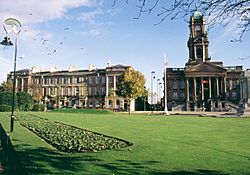Hamilton Square facts for kids
Quick facts for kids Hamilton Square |
|
|---|---|
| town square | |
 Birkenhead Town Hall(right) in Hamilton Square. |
|
| Design: | James Gillespie Graham |
| Construction: | 1825–1847 |
| Owner: | Wirral Metropolitan Borough Council |
| Location: | Birkenhead, Wirral, England |
Hamilton Square is a famous town square in Birkenhead, Wirral, England. It was designed by Edinburgh architect James Gillespie Graham. This square has many buildings built in the Georgian style. It has the most Grade I listed buildings (very important historic buildings) outside of London. Only Trafalgar Square in London has more. The square is named after the family of Scottish shipbuilder William Laird's wife.
Contents
History of Hamilton Square
Birkenhead's Early Days
In 1801, Birkenhead was a small village. It was located on the banks of the River Mersey. Only about 110 people lived there. Nearby, the big port city of Liverpool was much larger and busier.
William Laird's Vision
In 1824, William Laird started a boiler factory. This factory was near Wallasey Pool, north of Woodside. This site soon grew into a large shipbuilding yard. By 1831, Birkenhead's population had grown to 2,790 people. As the town became more important, Laird had big plans for the area. He bought land around Birkenhead in 1824. He wanted to build a brand new town there.
Designing the Square
Laird asked James Gillespie Graham to design the new town. Graham was a top architect from Edinburgh. He planned a square and streets similar to Edinburgh New Town. His design included long, straight, wide roads. These roads would be lined with fancy town houses. Hamilton Square was placed in a spot where it would look best. It could be seen from the Liverpool waterfront. This showed how proud Birkenhead was of its growth.
Work on the new town started in 1825. It began on the eastern side, around Hamilton Square. However, there were money problems in the mid-1800s. Because of this, Hamilton Square was the only part of Graham's big plan that was fully finished. The square got its name from Mary Hamilton. She was the mother of Laird's wife, Agnes MacGregor. Mary's brother, William Hamilton, was also one of Laird's business partners.
Birkenhead Town Hall
Hamilton Square was meant to be the main place for the town's government. So, a space was left empty on the east side for a town hall. In 1835, part of this empty land was used for Birkenhead's first market. This market was between Hamilton Street and Chester Street. As more people moved to town, a much bigger market opened nearby in 1845.
Building the town hall started in 1883. This was almost 60 years after work on the square began. Birkenhead Town Hall opened in 1887. It was designed by a local architect named Charles Ellison. The building is made of Scottish granite and sandstone. The sandstone came from a local quarry at Storeton. In 1901, the top part of the clock tower was rebuilt. This happened after it was damaged by a fire.
What You Can See in Hamilton Square
The buildings around Hamilton Square are all in the Georgian style. No two sides of the square look exactly the same. The private gardens in the square became public in 1903.
Monuments and Buildings
The square has several important monuments:
- A cenotaph (a monument to soldiers who died in war) in front of the town hall.
- A large Queen Victoria Monument.
- A statue of John Laird, who was William Laird's son.
Number 63 Hamilton Square was once the home of John Laird. He was Birkenhead's first Member of Parliament. This building is now a Grade I listed building. Other listed buildings include numbers 1–18, 35–50, and 58–62 in Hamilton Square.
Modern Changes
Part of the square was built between 1825 and 1847. Between 1995 and 2002, some areas were made for walking only. This was part of a big project in the Hamilton Quarter area. In 2016, a plan to reopen the square to car traffic was stopped.
Hamilton Square railway station opened in 1886. This made it easy for people to travel to and from the square.


